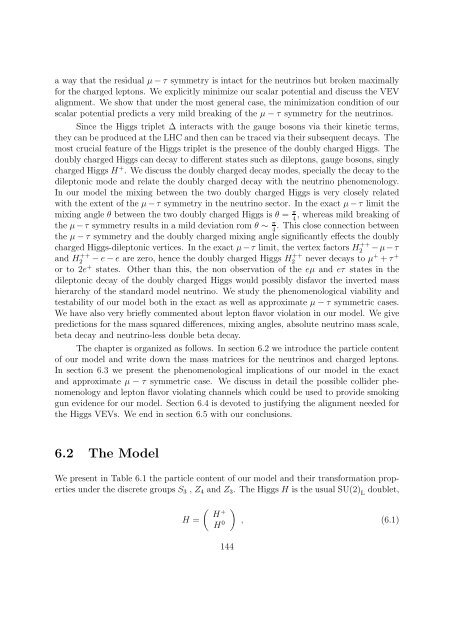PHYS08200604017 Manimala Mitra - Homi Bhabha National Institute
PHYS08200604017 Manimala Mitra - Homi Bhabha National Institute
PHYS08200604017 Manimala Mitra - Homi Bhabha National Institute
Create successful ePaper yourself
Turn your PDF publications into a flip-book with our unique Google optimized e-Paper software.
a way that the residual µ−τ symmetry is intact for the neutrinos but broken maximally<br />
for the charged leptons. We explicitly minimize our scalar potential and discuss the VEV<br />
alignment. We show that under the most general case, the minimization condition of our<br />
scalar potential predicts a very mild breaking of the µ−τ symmetry for the neutrinos.<br />
Since the Higgs triplet ∆ interacts with the gauge bosons via their kinetic terms,<br />
theycanbeproducedattheLHCandthencanbetracedviatheir subsequent decays. The<br />
most crucial feature of the Higgs triplet is the presence of the doubly charged Higgs. The<br />
doubly charged Higgs can decay to different states such as dileptons, gauge bosons, singly<br />
charged HiggsH + . Wediscuss thedoubly charged decay modes, specially thedecay tothe<br />
dileptonic mode and relate the doubly charged decay with the neutrino phenomenology.<br />
In our model the mixing between the two doubly charged Higgs is very closely related<br />
with the extent of the µ−τ symmetry in the neutrino sector. In the exact µ−τ limit the<br />
mixing angle θ between the two doubly charged Higgs is θ = π , whereas mild breaking of<br />
4<br />
the µ−τ symmetry results in a mild deviation rom θ ∼ π . This close connection between<br />
4<br />
the µ−τ symmetry and the doubly charged mixing angle significantly effects the doubly<br />
charged Higgs-dileptonic vertices. In the exact µ−τ limit, the vertex factors H 2 ++ −µ−τ<br />
and H 2 ++ −e−e are zero, hence the doubly charged Higgs H 2 ++ never decays to µ + +τ +<br />
or to 2e + states. Other than this, the non observation of the eµ and eτ states in the<br />
dileptonic decay of the doubly charged Higgs would possibly disfavor the inverted mass<br />
hierarchy of the standard model neutrino. We study the phenomenological viability and<br />
testability of our model both in the exact as well as approximate µ−τ symmetric cases.<br />
We have also very briefly commented about lepton flavor violation in our model. We give<br />
predictions for the mass squared differences, mixing angles, absolute neutrino mass scale,<br />
beta decay and neutrino-less double beta decay.<br />
The chapter is organized as follows. In section 6.2 we introduce the particle content<br />
of our model and write down the mass matrices for the neutrinos and charged leptons.<br />
In section 6.3 we present the phenomenological implications of our model in the exact<br />
and approximate µ − τ symmetric case. We discuss in detail the possible collider phenomenology<br />
and lepton flavor violating channels which could be used to provide smoking<br />
gun evidence for our model. Section 6.4 is devoted to justifying the alignment needed for<br />
the Higgs VEVs. We end in section 6.5 with our conclusions.<br />
6.2 The Model<br />
We present in Table 6.1 the particle content of our model and their transformation properties<br />
under the discrete groups S 3 , Z 4 and Z 3 . The Higgs H is the usual SU(2) L<br />
doublet,<br />
H =<br />
(<br />
H<br />
+<br />
H 0 )<br />
144<br />
, (6.1)
















